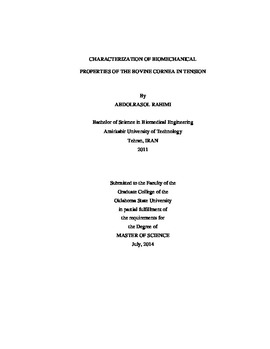| dc.description.abstract | Cornea is a soft tissue with the principal function of transmitting and refracting light rays. It is composed of many different layers; epithelium, Bowman's layer, stroma, Decemet's membrane, and endothelium. It is well developed that biomechanical properties of the cornea are mainly due to the microstructure and composition of the stroma layer. The stroma constitutes 90% of the thickness and is mainly composed of collagen fibrils, proteoglycans, and interstitial fluid. The cornea in in-vivo condition is constantly subjected to membrane tensile stresses caused by the intraocular pressure. Therefore, a detailed understanding of its mechanical behavior in tension is required to enhance the accuracy of numerical models. Although uniaxial tensile experiments have been widely used to determine the tensile stress-strain behavior, available data in the literature shows a large variation.In this thesis, a uniaxial tensile testing machine was first designed and built. This custom-made machine was used to investigate the effects of different parameters, such as loading rate, structural anisotropy, hydration, and riboflavin-UVA crosslinking, on immediate stress-strain and time dependent stress-relaxation behavior of the cornea. To this end, corneal strips with known dimensions were dissected from bovine eyes and were tested under immersed conditions. It was observed that the corneal stroma is a viscoelastic anisotropic material. In particular, the corneal strips obtained from the inferior-superior direction were significantly stiffer than those dissected from the nasal-temporal orientation. Moreover, the tensile stiffness of the samples increased with increasing the loading rate. Through testing corneal strips at different hydration levels, it was shown that hydration significantly affects the tensile properties; both tensile stiffness and stress significantly decreased with increasing hydration. Finally, the riboflavin and UVA irradiation were used to crosslink the corneas and investigate the biomechanical effects of collagen crosslinking treatment. It was seen that the riboflavin/UVA treated bovine corneal samples became significantly stiffer. The numerical exponential and power-law expressions were successfully represented the experimentally measured stress-strain curves. In conclusion, the present research study not only characterized the mechanical behavior of bovine cornea in tension, but it also provided new possible explanations for the existing wide variation in the reported corneal tensile behavior. The proper characterization of material properties is essential for developing more accurate computational models to predict corneal mechanical behavior. | |
